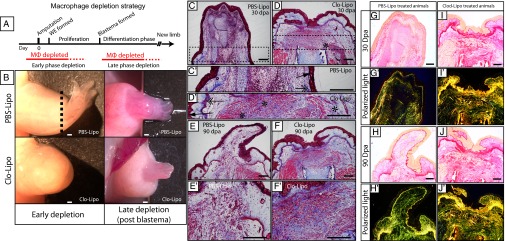Fig. 4.

Blockade of limb regeneration depends on early macrophage depletion. (A) Macrophage depletion strategy: early phase depletion targets blastemal formation and late phase depletion targets the redevelopment phase. (B) Injection of PBS liposomes (PBS-Lipo) has no effect on normal limb regeneration (n = 10). Maximal macrophage ablation before amputation (early phase depletion) blocks limb regeneration in all animals (n = 10). Amputation plane is shown by a dotted line. Ablation of macrophages after blastemal formation (late phase depletion) allows regeneration to proceed to completion with a reproducible delay in defined regeneration stages (n = 5). (C) Control PBS-Lipo–injected animals enter paddle stage at 30 dpa and show weak collagen reactivity to trichrome staining (C′: dashed box marks inset showing high-magnification images). (D) Triple Clo-Lipo–treated animals do not initiate regeneration at 30 dpa and the failed regenerate (D′: high-magnification inset) features a complete basement membrane (arrow), a dense stratum compactum (double arrows), pronounced epidermal tongues (arrowhead), and extensive collagen deposition (asterisks). Extensive collagen deposition is still evident in Clo-Lipo stumps at 90 dpa (F and F′) relative to control PBS-Lipo regenerates (E and E′). (G–J) Picosirius red staining was used to analyze collagen fiber density. (I, I′, J, and J′) Macrophage depleted failed regenerates show dense thick collagen fiber deposition at 30 and 90 dpa compared with regenerating control limbs (G, G′, H, and H′). Thin fibers stain green and thicker fibers stain yellow/red under polarized light. (Scale bars, 100 μm.)
